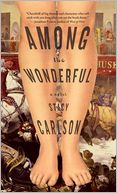Carlson ’96 Sets Her Debut Novel in Marvelous 1840s Manhattan

In her first novel, Among the Wonderful (Steerforth Press), Stacy Carlson ’96 brings to life 1840s New York City, a time when Phineas T. Barnum is a young man, freshly arrived to the area and still unknown to the world. Barnum transforms a dusty natural history museum into a place of human wonders and an extraordinary live animal menagerie, which will become not only the nation’s most popular attraction, but also a catalyst that ushers America out of a culture of glassed-in exhibits and into the modern age of entertainment.
In this kaleidoscopic setting, Carlson focuses on two compelling characters. Emile Guillaudeu is the museum’s grumpy taxidermist, who is horrified by the chaotic change Barnum brings to his beloved institution. Ana Swift is a professional giantess plagued by chronic pain and jaded by a world of gawkers. They are part of a world where upper Manhattan is still untrammeled wilderness, the Five Points is at the height of its bloody glory, and within the walls of Barnum’s museum, ancient tribal feuds play out in the midst of an unlikely community of marvels.
In an article about Among the Wonderful in the San Jose Mercury News, Georgia Rowe says, “Carlson spent seven years researching and writing the book, poking around various museums and poring through microfiche at the New York Public Library.”
“Mostly, Carlson gleaned information from archived newspapers. ‘I fell in love with reading old newspapers,’ she says. ‘You get such a unique glimpse from them — crime, civic meetings, catastrophes, everything that was being advertised. Just the way the Internet has proliferated now, there was a similar blossoming of newspaper culture during that time. Information was everywhere, in all different flavors.’ ”

The Publishers Weekly review said, “Carlson beautifully evokes 1840s Manhattan—from the teeming downtown to the wilds of undeveloped northern Manhattan. The acrobats, bearded lady, Australian tribesman, Native Americans, and myriad of bizarre animals offer a constant source of fascination and surprise, and while Carlson rightfully revels in the oddities and curiosities, she also creates emotionally resonant characters who, despite being freakishly tall or joined at the hip, are driven by desires, fears, and that familiar need for human connection.”
In her review in The New York Times, Andrea Thompson wrote, “Carlson ably exploits this historical milieu, describing the milling crowds in the exhibition halls; the malodorous, dangerous alleyways of the slum called Five Points; the swampy, still-wild edges of upper Manhattan. … [She] writes sensitively, often beautifully, of the desire to be free of the gaze of others, of the misery of serving as a mirror in which others may see themselves.”
In his review in The Stranger, Paul Constant said, “Carlson [sets] her story before the dawn of the modern circus, in the little-explored days when Barnum was a museum man … And (Ana) Swift is a most charming narrator with which to explore this world. … The climax is a beautiful piece of operatic writing, and several moments sing with a naughty transgression. The great mystery of Wonderful is that Barnum, the flashiest character in the 1800s, doesn’t keep center stage. Instead, all our focus, and the entirety of our affection, is directed to the noticeably slouching giantess at the fringes of the action. That’s some kind of show-business magic at work.”

